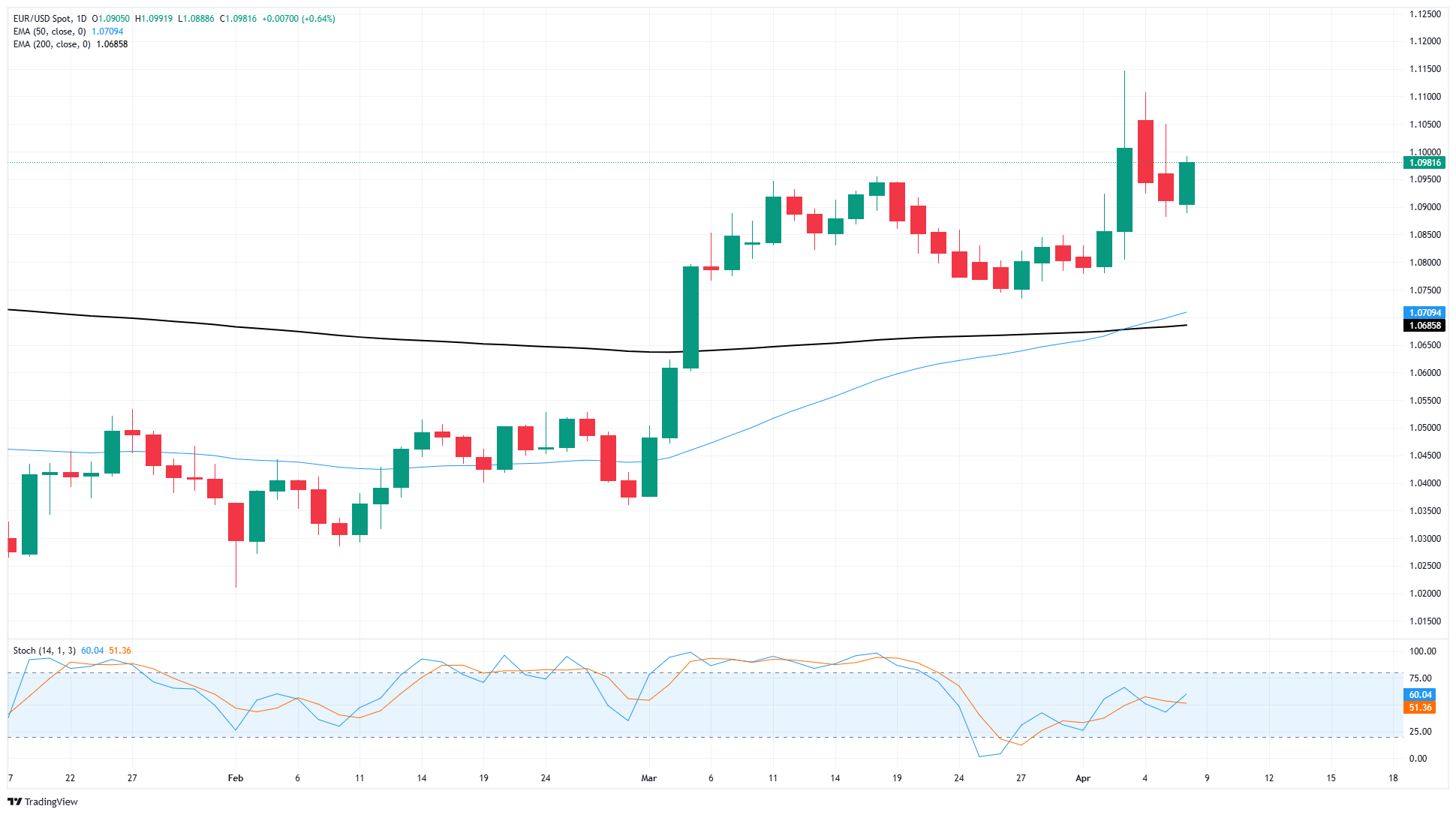EUR/USD fights off bearish flows, but tariffs and cautionary Fed remain
- EUR/USD clawed back ground on Tuesday, but remains below 1.1000.
- European data takes a backseat as markets focus on rate cut bets and trade policy fallout.
- Key data coming up later this week includes US inflation and consumer sentiment figures.
EUR/USD caught a mild bullish recovery on Tuesday, snapping a two-day losing streak and chalking in some last-minute gains before the Trump administration’s widespread “reciprocal” tariffs come into effect on April 9. Fedspeak from key policymakers is beginning to clash with rising market expectations of Fed rate cuts through the rest of 2025, putting markets on a collision course with the negative impacts of far-reaching tariffs.
Forex Today: Markets’ attention shifts to the Fed Minutes
Overall, the European economic data calendar is light this week, and Tuesday provided a refreshing break from the usual barrage of geopolitical and trade news typical of recent weeks under the Trump administration. However, several important Federal Reserve (Fed) officials seized the moment to remind us that uncertainty and the adverse inflationary effects of US tariffs will complicate, not facilitate, the Fed's process of cutting rates.
Fed rate cut hopes continue to rise
Unfazed by this, rate traders are increasingly betting that the Fed will feel compelled to initiate a rate-cutting cycle before the year ends, as the negative economic fallout from those same tariffs could nudge the US toward recession. Data from the CME’s FedWatch Tool indicates that rate swap traders are starting to speculate that a quarter-point rate trim might come as soon as May. Nevertheless, most participants in the rate market still deem a 25 basis point cut in July as more probable, anticipating a total reduction of 100 basis points or more by year-end.
Fed's Goolsbee: Tariffs are way bigger than anticipated
Fed's Daly: I'm a little concerned inflation may pick back up
Consumer Price Index (CPI) inflation data is due out on Thursday, while Producer Price Index (PPI) inflation and the University of Michigan (UoM) Consumer Sentiment Index results will be released on Friday. This will represent the final set of significant US inflation and sentiment figures from the ‘pre-tariff’ period of 2025, serving as critical benchmarks for the remainder of the year.
EUR/USD price forecast
EUR/USD cut off a two-day losing streak on Tuesday, marking in a near-term technical support level near 1.0900. However, bidding pressure remains thin, and a mild push from the short side could easily push Fiber back to the 200-day Exponential Moving Average (EMA) just south of 1.0700.
Despite a sharp recovery by the Euro through March, a stiff resistance zone remains priced in between 1.1100 and 1.1000.
EUR/USD daily chart

Euro FAQs
The Euro is the currency for the 19 European Union countries that belong to the Eurozone. It is the second most heavily traded currency in the world behind the US Dollar. In 2022, it accounted for 31% of all foreign exchange transactions, with an average daily turnover of over $2.2 trillion a day. EUR/USD is the most heavily traded currency pair in the world, accounting for an estimated 30% off all transactions, followed by EUR/JPY (4%), EUR/GBP (3%) and EUR/AUD (2%).
The European Central Bank (ECB) in Frankfurt, Germany, is the reserve bank for the Eurozone. The ECB sets interest rates and manages monetary policy. The ECB’s primary mandate is to maintain price stability, which means either controlling inflation or stimulating growth. Its primary tool is the raising or lowering of interest rates. Relatively high interest rates – or the expectation of higher rates – will usually benefit the Euro and vice versa. The ECB Governing Council makes monetary policy decisions at meetings held eight times a year. Decisions are made by heads of the Eurozone national banks and six permanent members, including the President of the ECB, Christine Lagarde.
Eurozone inflation data, measured by the Harmonized Index of Consumer Prices (HICP), is an important econometric for the Euro. If inflation rises more than expected, especially if above the ECB’s 2% target, it obliges the ECB to raise interest rates to bring it back under control. Relatively high interest rates compared to its counterparts will usually benefit the Euro, as it makes the region more attractive as a place for global investors to park their money.
Data releases gauge the health of the economy and can impact on the Euro. Indicators such as GDP, Manufacturing and Services PMIs, employment, and consumer sentiment surveys can all influence the direction of the single currency. A strong economy is good for the Euro. Not only does it attract more foreign investment but it may encourage the ECB to put up interest rates, which will directly strengthen the Euro. Otherwise, if economic data is weak, the Euro is likely to fall. Economic data for the four largest economies in the euro area (Germany, France, Italy and Spain) are especially significant, as they account for 75% of the Eurozone’s economy.
Another significant data release for the Euro is the Trade Balance. This indicator measures the difference between what a country earns from its exports and what it spends on imports over a given period. If a country produces highly sought after exports then its currency will gain in value purely from the extra demand created from foreign buyers seeking to purchase these goods. Therefore, a positive net Trade Balance strengthens a currency and vice versa for a negative balance.

